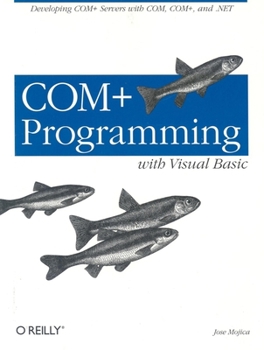COM+ Programming with Visual Basic
Select Format
Select Condition 
Book Overview
The importance of a book like COM+ Programming with Visual Basic lies in the fact that the Visual Basic programming environment is designed to hide as many low-level system details as possible. While this approach can speed development time by letting you focus on the task at hand, it actually hinders the process when it obscures details you need to understand or control. Such is often the case for programmers who are developing components that take advantage of COM+ services. COM+ Programming with Visual Basic takes aim squarely at the information needs of these developers.For instance, despite the marketing hype about COM+ as the new and improved version of COM, classic COM is very much the foundation on which COM+ is built: COM+ components are a particular kind of COM component. Visual Basic hides almost all COM implementation details; yet it is precisely in the area of COM+ programming that these hidden details are most important. Therefore, we've devoted significant content to exploring COM internals: Interface-based programming How COM interfaces work internally How COM components are activated How versioning COM components works in Visual Basic The second section focuses on incorporating individual COM+ services, like transaction support, security, and asynchronous operations, into applications. The author concludes by discussing what you need to learn to transition to Microsoft's coming .NET framework.Regardless of what lies ahead for .NET, many distributed systems are being built today with COM+. COM+ Programming with Visual Basic focuses on topics relevant to distributed applications that are here to stay: How to use interfaces Passing objects by reference or by value What it means to have multithreaded applications How declarative programming works How to program within a distributed transaction How to add role-based security to applications There's simply no other documentation available for much of what's in COM+ Programming with Visual Basic. It's destined to be the resource behind the most robust, efficient, high-performance COM+ applications.
Format:Paperback
Language:English
ISBN:1565928407
ISBN13:9781565928404
Release Date:July 2001
Publisher:O'Reilly Media
Length:368 Pages
Weight:1.30 lbs.
Dimensions:0.9" x 7.0" x 9.2"
Customer Reviews
2 ratings
A VB book with internals info
Published by Thriftbooks.com User , 23 years ago
If you think that VB is not synonymous with only point and click, drag and drop, then this book is for you. The book covers COM, COM+ and ends with an introduction to VB.NET. Mr Mojica covers the first two topics at a level of detail that is usually skipped (to the reader's detriment) in cookbook-style books.Although this book may not be for everyone, some of us are interested in how COM and COM+ work behind the scenes, and want more depth out of a book than one could get by reading the documentation and working the SDK examples. This is that book.
Great Book!
Published by Thriftbooks.com User , 23 years ago
After having read and used Scott Hillier's COM+ book for the last year, I've finally found the perfect book to explain the parts Scott skipped. As the preface says, if you are not interested in HOW COM+ works, then get another book. If you are looking for cookie cutter code, get another book. This book explains in good detail how COM+ (and COM and MTS for that matter) works internally. It points out many mistakes VB programmers make in working with COM+, why they are made and how to overcome them. And it is very easy to read, especially if you are moderately familiar with the topics. I just got the book last night and I already love it. O'Reilly does it again!





